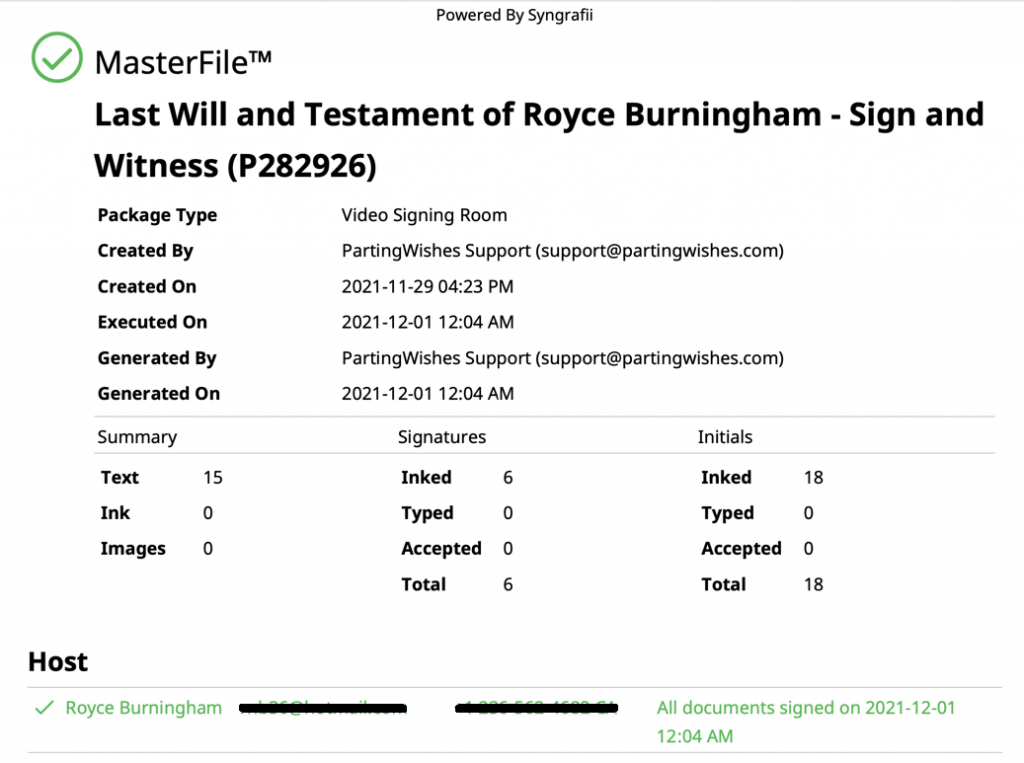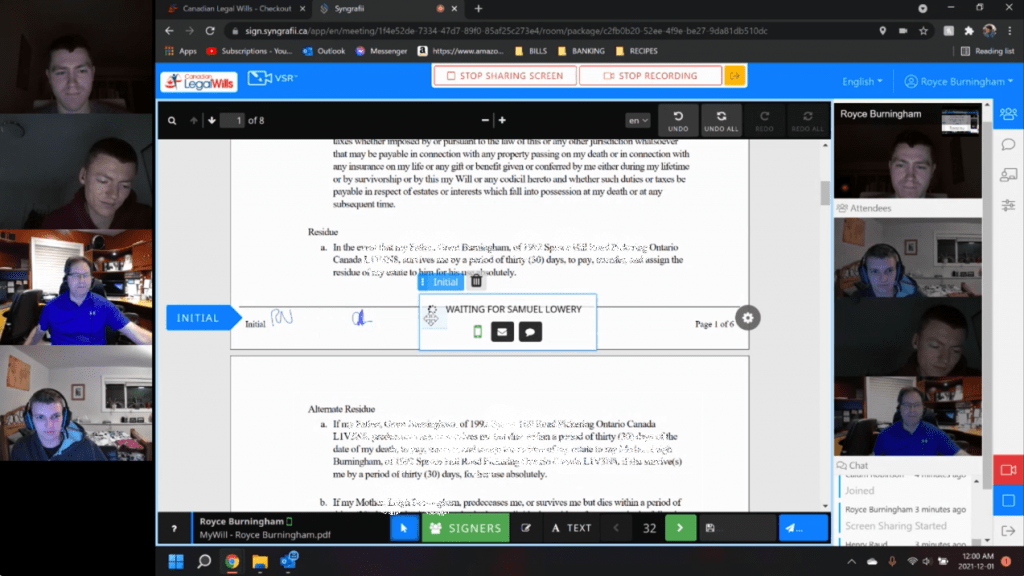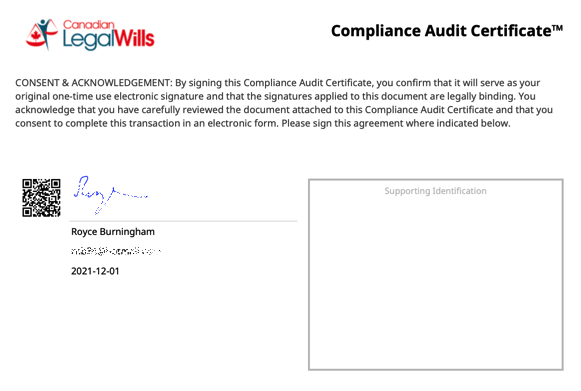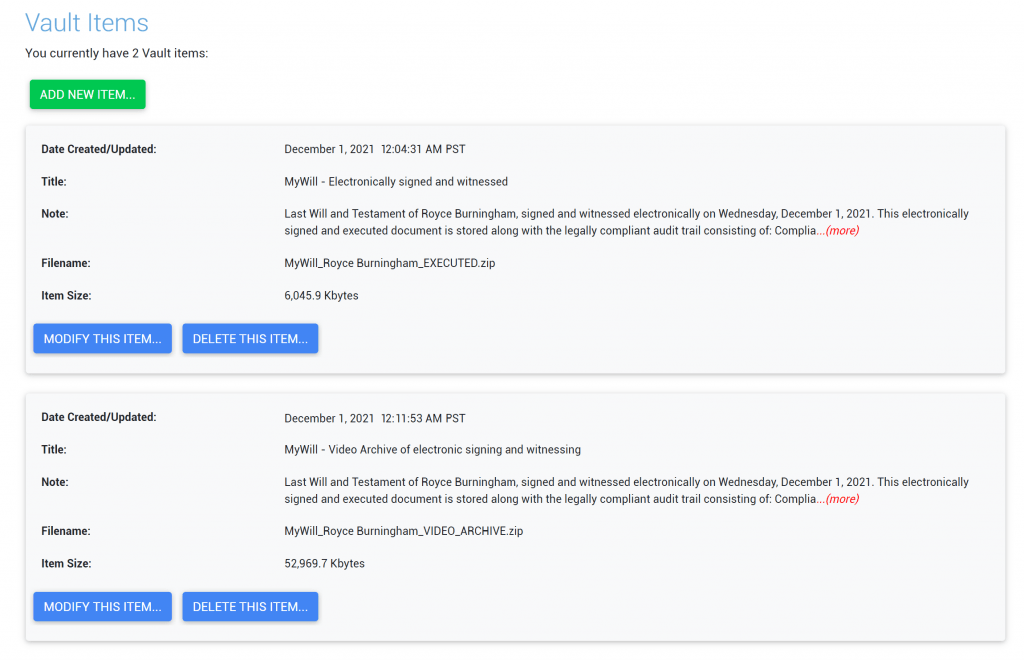On December 1st, 2021, new laws came into effect in British Columbia that allowed BC residents to create an “electronic Will” – a document signed and stored entirely online. After the emergence of the COVID-19 pandemic, most Canadian Provinces allowed remote witnessing of Wills – meaning that your witnesses could watch you sign the document over a video link. But this law still required the physical document to be mailed to each participant, to be signed in turn. The amendment to the BC Wills, Estates and Succession Act, through legislation called Bill 21, allowed, for the first time, a Will to be signed electronically and stored digitally.
LegalWills.ca has been working with a Canadian company, Syngrafii, for a number of months to pull together a truly unique solution to take advantage of these law changes. On December 1st, at 12:01am, Royce Burningham became the first Canadian in history to electronically sign his Will.
How do we know that this was the first electronically signed Will?
There have certainly been other claims to this title, but fortunately, the LegalWills.ca solution comes with an automatic activity trace called a MasterFile™. This is automatically uploaded into the account holder’s Vault within LegalWills.ca. Royce was kind enough to share his MasterFile™ with us.
 First completed electronically signed Will at 4 minutes past midnight Pacific Time, December 1st, 2021
First completed electronically signed Will at 4 minutes past midnight Pacific Time, December 1st, 2021The complete MasterFile™ is 23 pages long and provides a detail of every action taken on the video call.
How was the document signed?
We do have a step-by-step description in another blog post, but this is a summary.
Within the LegalWills.ca MyWill™ service, residents of British Columbia are able to schedule a signing session, and invite their witnesses.
 Scheduling an e-signing session from within LegalWills.ca
Scheduling an e-signing session from within LegalWills.caAt the appointed time, you and your witnesses join the call and step through the signing process
 Signing a Will using LegalWills + Syngrafii technology
Signing a Will using LegalWills + Syngrafii technologyEach attendee signs and initials on a signature pad that is texted to their mobile device. As a result, each signature is a unique and authentic one-time-use signature of each signer. This is very different to an Adobe or DocuSign facsimile of a signature.
At the conclusion, the signed Will is then automatically placed into the account holder’s Digital Vault at LegalWills.ca.
What documents are created from an electronic signing?
There are four key files generated from an electronic signing. All four of these are automatically placed into the digital vault of the account holder:
- The signed and executed electronic Last Will and Testament, complete with witness initials and signatures.
2. The Compliance Audit Certificate™, that has all attendee signatures and any supporting identification documents.
 Compliance Audit Certificate
Compliance Audit Certificate3. The MasterFile™ log, which is a full audit trail of the complete e-signing process.
4. A full video recording of the entire session.
Where are these documents now?
These four documents are all now in Royce Burningham’s digital vault at LegalWills.
 Digital Vault including all trace files from the signing session
Digital Vault including all trace files from the signing sessionThis means that if there was a house fire or natural disaster, the legally signed document is available in the cloud. Securely stored within the digital vault service. There is absolutely no danger of this document being accidentally destroyed or lost.
How does the Executor get these documents when they need them?
At LegalWills.ca we have created a Keyholder® service that allows you to name trusted individuals as Keyholders® and grant them access to the documents in your Vault. Typically, you would allow your Executor to have access to your Vault by naming them as a Keyholder® and giving them a unique, secure Keyholder® ID.
At the appropriate time, the Keyholder® can login, and request access to your Vault. As the account holder, you can determine how many days must pass before the contents of the Vault are made available to the Keyholder®. After that time has passed, your Executor will then be able to download the documents.
The Will, Compliance Audit Certificate™, and MasterFile™ can then all be printed and submitted to the probate courts.
If there is a challenge made to the Will based on a claim that the document was signed inappropriately, a full video of the signing session can be submitted as evidence.
How secure is an electronic Will?
Firstly, it is important to answer this question in the context of the reliability of our traditional signing process on a piece of paper. It is extremely common for Wills to be created fraudulently. It simply requires a mimicking of a scrawled signature. In 2021, it is unreliable to use a scrawled signature as a means to identify somebody.
Furthermore, it is extremely common for Wills to be lost or accidentally destroyed. Any house fire or natural disaster will destroy all contents of a house, and paper is not a very resilient medium for preserving a Will.
It is also very common for Wills to simply go undiscovered. Family members don’t know where the Will is stored, and if the Will is not found, it is the same as not having a Will in place at all.
Electronically signing and storing the document addresses all of these issues.
The MasterFile™ and video recording of the signing session guards against any unscrupulous activity occurring at the time of signing. Storing the document in the cloud makes it a very resilient option for preserving the Will. Being able to name Keyholders® with access to the Vault means that the document gets into the right hands at the right time and not before.
But these documents are all held securely in the Vault. Nobody can access these files other than the account holder and the trusted Keyholder®. Furthermore, this solution was developed by Ottawa-based LegalWills.ca and Toronto-based Syngrafii.
E-Sign your document today
If you are living in BC, please explore the option to e-sign your Last Will and Testament. We hope that other Provinces and Territories will soon catch up, and offer this as an option to other jurisdictions in Canada.
Tim Hewson is one of the founders of LegalWills.ca.
He has over 20 years of experience helping people to write their Will and other estate planning documents. He has been interviewed by many of the major news media outlets including CTV, Global News, The Toronto Star, and other leading Canadian publications. He has also contributed to a number of financial planning books.
Throughout his career, Tim has written extensively on the subject of Will writing and estate planning.
Latest posts by Tim Hewson
(see all)Like this:
Like Loading...
Related